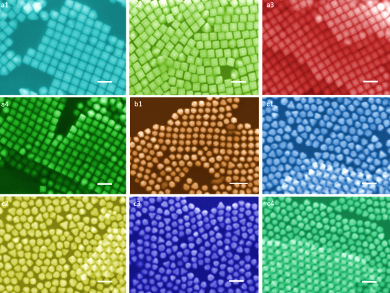Silver nanoparticles with controlled shapes and sizes have potential applications in catalysis and surface-enhanced Raman scattering (SERS). Current methods for the synthesis of silver nanocubes, cuboctahedra, and octahedra involve high reaction temperatures, organic solvents for washing, and result in relatively large particles with sizes in the 100–300 nm range.
Chieh Chiang and Michael H. Huang, National Tsing Hua University, Hsinchu, Taiwan, have developed a synthesis of Au–Ag core–shell nanocubes, cuboctahedra, and octahedra with tunable sizes and edge lengths below 50 nm in aqueous solution. The team used octahedral Au nanocrystals with an edge length of 29 nm as cores, and deposited silver on them at only 30 °C to form the desired core-shell nanoparticles.
The synthesized particles have high photothermal efficiency upon blue light irradiation, which is caused by their silver shells according to the team. The researchers hope that availability of these nanocrystals with several different shapes in large quantities will help to broaden the use of silver nanoparticles.
- Synthesis of Small Au-Ag Core-Shell Cubes, Cuboctahedra, and Octahedra with Size Tunability and Their Optical and Photothermal Properties,
Chieh Chiang, Michael H. Huang,
Small 2015.
DOI: 10.1002/smll.201502513




